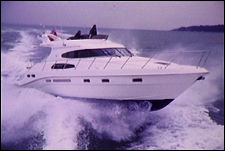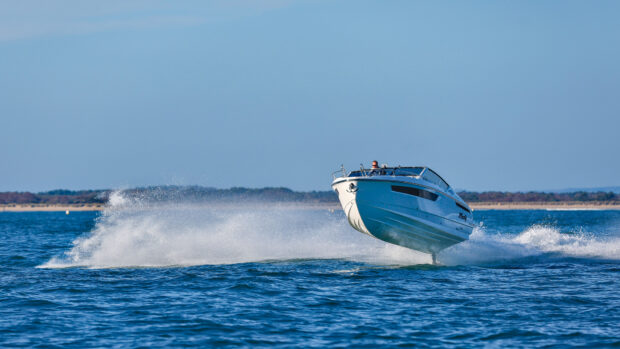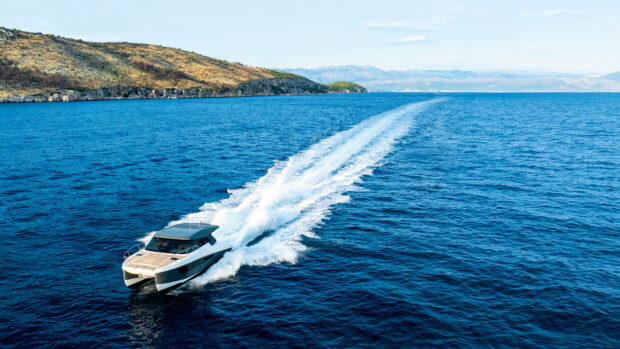For those buying boats in the T46's size bracket, the classic dilemma is whether to go for an aft cabin, or aft cockpit and flybridge.
For those buying boats in the T46’s size bracket, the classic dilemma is whether to go for an aft cabin, or aft cockpit and flybridge. That additional privacy provided by the aft cabin might be essential to you if you are cruising with friends, but so might that extra space on the flybridge and the elevated view that goes with it.
Sealine, however, have a neat solution to the quandary: they still make conventional flybridge boats. But when they give you an aft cabin, as on this T46 and their F43, they also throw in an aft cockpit and a flybridge. So have Sealine dished up the perfect recipe for boating bliss?
Let’s deal with one of the most important questions straight away: with the cockpit footwell intruding into the aft cabin, does the cabin still work successfully?
OK, there is a 16in-deep (400mm) intrusion directly over the bed. But in the same way that you do not ‘see’ your spectacle frames, my feeling is that after a dozen trips aboard, your brain would not bother to register the lump. Sealine have resisted the temptation to cover it with mirrors (they are British, after all), understanding instead that it’s the space around the foot of the bed that is the key. There is more room here than in the typical forward sleeping cabin, and the airy feeling is enhanced by the oversized escape hatch, which provides a great view out and lets light flood in through the transom. There’s also space for lots of stowage: two hanging lockers, six drawers, and two dressing tables one of which you can use sitting on the bed. If you both stagger out of bed in the morning at the same time, you will appreciate the separate shower and toilet, which are cosy, but I’d choose the versatility of two compartments any day. So the aft cabin works on all counts very successfully.
Accommodation
By comparison, the ensuite day heads and forward cabin are fairly conventional. Two good points though – the shower is a domestic-sized cubicle with a proper door. And the cabin has better-than-average stowage, especially bearing in mind that it’s the second cabin. If you put your kids in here though, give them stilts so they can reach the roof-mounted light switches. Sealine offer four mid-cabin options. Given the size of the dinette it would replace, it should be very spacious as a third cabin – about the same area as the forward cabin.
Opting for the third cabin, however, would take away from the galley, which in the T46’s two-cabin form is a joy to work in, as it’s surrounded by the open space of the dinette, and the cook could make use of the nearby table if the worktop became overloaded. The third-cabin option would remove these two benefits, and the fridge and freezer, which are currently in their own tall cabinet, would consume locker space in the galley. It would not be a bad aRangement – but it’s just unusually good as it is.
My only complaint is the solitary diminutive drawer, which seems wholly inadequate it’s much safer to store things in drawers when the boat’s bouncing around in waves. Sealine assure me that the small dining table on this prototype T46 is being replaced with one that will do justice to the seating, which should provide enough space for four adults to dine together. But hi-lo saloon table is just one of the places to eat: there’s the cockpit and the spacious flybridge. The vast amount of stowage around the dinette is easy to get to, and can either be used as general stowage or as a supplement to the galley. This generous assortment of eye-level lockers, cabinets and under-seat stowage compensates for there being no stowage in the saloon, except for the more unwieldy spaces under the settees.
Up three steps in the saloon, there’s comfortable seating for four around the table six if you drag the loose two-seater across the floor. All the cabinet space on the port side is absorbed by the TV and an icemaker. Sealine have a small stainless steel fiddle running around the countertop above the drinks cabinet. It’s a shame that they have not continued this feature throughout the boat, as they make good handrails for when the going gets rough, and the countertops become more useable. Ventilation is fine with two pairs of electrically operated opening windows, and the lighting should be good day or night, with large saloon windows and plenty of halogens.
For the joinery, Sealine have gone for Alpi cherry, sliced into thin strips and re-glued to create a pseudo-grain effect. This satin-finished joinery provides a restful alternative from the ubiquitous high-gloss American cherry.
On deck
Moving around the boat is safe thanks to high guardrails and deep vertical toerails, which rise to 5in (130mm) at the bow. These are complemented by the unbeatable non-slip properties of teak laid decks, which are standard everywhere except for the side decks. Sealine cannily overhang the teak on the flybridge steps, so there is no danger of slipping off a shiny glassfibre edge as you descend.
If there is a drawback to this aft-cabin, aft-cockpit formula (see Design Notes) it’s deck stowage, but Sealine have done quite well here. Overhead in the flybridge roof is Sealine’s usual clam-shell stowage for the integrated canopy, and the table stowage. And there’s a giant foredeck locker, large enough for all the fenders and warps. A liferaft would live in the dedicated cockpit locker, and other paraphernalia in the two remaining lockers. What is impossible to provide is a lazarette to swallow the tender and its outboard, so this normally has to hang on davits. However, Sealine do conceal a set of flip-out tender chocks in the bathing platform locker, so a tender could be carried here, weather permitting.
Handling and Performance
Driving the T46, the first thing you notice is that it appears to be a really slow boat. So you try and open the throttles, only to discover that the boat is already travelling flat out at over 30 knots. This misleading sensation is partly due to its gentle motion through the water. At 30 knots in a slight chop, I could walk safely up the flybridge steps with mugs of coffee in both hands and had no urge to grab the handholds. But the T46’s real trick is its unbelievably low level of noise. MBY has tested a quieter boat (the nine-knot Linssen Grand Sturdy 460, MBY March 1998), but this is the quietest 30-knot flybridge boat I’ve driven. At cruising Speeds on the flybridge, it’s eerie. You can clearly hear the water washing off the chines above the noise of the engines, and the levels in the saloon and aft cockpit are also very low. Evidently, the aft cockpit and cabin combination is damping the sound, but the electronic engine synchronisation also contributes, as it eliminates the off-beat throbbing sound entirely.
Engines Twin Volvo Penta
TAMD73P EDC
430hp @ 2,600rpm
6cyl 6.7-litre turbo diesels
1.75:1 gearbox ratio
4-bladed props
23in diam, 31in pitch
(584mm 5 787mm)
73% blade area ratio
Sealine were experimenting with propellers on this prototype boat, so the engines were still over-revving (2,750rpm vs 2,600rpm). Presumably Sealine will eventually sort out the propellers, so we have calculated what we feel is a realistic top Speed and Range – 31.0 knots, 210 miles @ 2,600rpm – based on the 30.4 knots measured at 2,750rpm, and better propellers. It doesn’t matter what cruising Speed you pick, as the T46 is happy anywhere above about 22 knots. On our test day, the Solent didn’t treat us to anything that could really challenge the handling of a 46ft (14m) 15-tonne boat. However, in these conditions, the T46 behaved competently on all points turning, upwind, downwind and in a beam sea.
Controlling the boat in rougher conditions should be no problem, as the flybridge helm is good and the internal helm is outstanding. Both positions have clear layouts (with paired warning gauges), and excellent ergonomics, including adjustable seats and footrests to improve the helmsman’s bracing. Visibility is superb below and it would also be great on the flybridge if Sealine raised the seat by 6in (150mm).
It’s far easier for boatbuilders to argue the case for electronic charts and so omit the chart table (here’s another boat without one), but I have only met two owners to date who don’t back up their electronic navigation with paper charts. I suggest that these numbers speak for themselves.
Engineering and construction
The enginerooms of aft-cabin boats are never as straightforward to access as their contemporary aft-cockpit counterparts. Still, it’s possible to perform daily service checks on the handed engines without too much of a struggle by removing the central floor panel. And more serious tasks can be performed by lifting other sections of the floor and removing the portable bearers. However, at their aft end, the gap between the engines narrows to 8in (200mm). So even with cold engines it’s extremely difficult to get to the fuel filters, raw-water strainers, seacocks, and gearbox dipsticks; with hot engines, it is impossible. Adding another floor panel over this area would solve what is a major shortcoming.
Lay-up weights (reinforcement only)
Deck 8.4oz/ft2 (2.55kg/m2)
Topsides 11.8oz/ft2 (3.60kg/m2)
Chine 27.5oz/ft2 (8.40kg/m2)
Bottom 15.7oz/ft2 (4.80kg/m2)
Keel 31.5oz/ft2 (9.60kg/m2)
The rest of the engineering installation is fine. Construction is along conventional lines the only difference between Sealine and most other production powerboat builders is that their laminators use a chopper gun to spray on their chopped-strand mat instead of laying it up by hand.
Verdict
The T46 has little that is wrong. The secondary engineroom access is the only significant shortcoming, and what few other drawbacks I found, such as the flybridge seat height, are easily corrected.
So does the T46 offer anything special? Well, in its two-cabin form, the T46’s galley is superb. It’s so spacious that there’s none of the claustrophobia associated with the ‘galley down’ formula. It may be that fewer people are doing any serious cooking on board these days, but it’s useful to have the option. And the internal helm is in the same league as the galley.
But the rest of the T46 hangs together well, even though its aft cabin and cockpit combination is unusual. On some larger boats it’s possible to hear your guests cleaning their teeth let alone doing anything noisier so the extra privacy provided by the aft cabin can be a godsend. And it seems that there is another significant spin-off from the aft cabin and cockpit combo very low noise levels from the engine. While lumpy conditions and the motion of the boat are tiring, being on the T46 underlined for me that a large part of fatigue is down to the continuous drone of the engines. Whatever the length of the cruise, T46 owners are going to arrive feeling a lot fresher than most. Overall, the T46 is Sealine’s best boat yet. MBY
Data
Overall length 46ft 4in (14.11m)
Hull length 43ft 4in (13.21m)
Beam 14ft 1in (4.30m)
Displacement 13.9 tonnes light
15.7 tonnes loaded
Draught 4ft 1in (1.25m)
Air draught 16ft 2in (4.93m)
Fuel capacity 354 imp gal (1,609lt)
Water capacity 100 imp gal (455lt)
RPM 1,800 2,000 2,200 2,400 2,600 (*2,600)
Speed 16.7 20.5 24.0 27.0 29.6 (*31.0)
Trim 5.0° 5.0° 5.0° 5.0° 5.0° (*5.0°)
GPH 14.6 18.4 24.0 31.7 41.6 (*41.6)
MPG 1.15 1.11 1.00 0.85 0.71 (*0.75)
Range 324 315 283 241 201 (*210)
Range allows for 20% reserve
70% fuel, 100% water, 2 crew
10in chop and ferry swells, Force 3
Flat out 31.0 knots, 210 miles @ 2,600rpm (*see Handling and Performance) Cruising 27.0 knots, 241 miles @ 2,400rpm Price from £319,938 inc VAT Price as tested £341,564 inc VAT Designers Sealine International, 1998 RCD category B (for 14 people) Contact Sealine International Tel: 01562 740900 Fax: 01562 747709 SOUND LEVELS dB(A) Saloon Cockpit Flybridge Cruising @ 27.0 knots 80 80 74 Flat out @ 31.0 knots 81 81 75
Design notes
It seems a rather bizarre twist of fate, but the design constraints imposed by the aft cabin have produced a more usable, safer, and more sociable cockpit than those you normally find in aft-cockpit boats. It’s more usable because the requirement for headroom around the central bed compels Sealine to run the seating all the way round the cockpit, so six adults can easily sit here and eat around a central table, with space to scatter kids around the coamings and the steps.
It’s safer because the journey up to the flybridge is shorter, and so the incline of the steps can be shallower and their treads deeper than normal. And although it might be a minor point, in dangerous following seas, the smaller cockpit would hold less water (but it would probably drain more slowly because of the missing transom opening). The sociable aspect is hard to quantify: I feel that because the aft cabin forces the cockpit upwards, the cockpit’s proximity to the flybridge makes it more likely to be used more often as an adjunct to the flybridge. Often it is just a place to pass through on the way to the saloon or the bathing platform.









